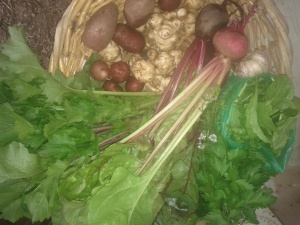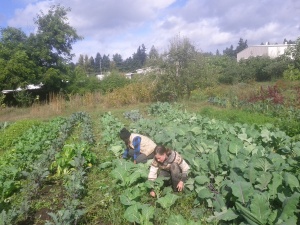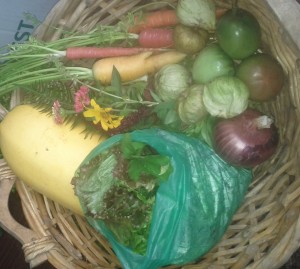This weeks bounty!
Sunchokes – Also called Jerusulam artichokes. These delicious tubers are in the aster family, which is the same as common plants like lettuce, artichokes, calendula, and sunflowers. The stem and leafy part of the plant tower 10-13 feet tall with small yellow flower “bursts of sun” that opened when the overcast skies became more frequent in late september. Sunchokes have some health benefits “Because normal digestion does not break inulin down into monosaccharides, it does not elevate blood sugar levels and may, therefore, be helpful in the management of diabetes.”(Wikipedia). Delicous thinly sliced and steamed, sautéed, or roasted. If boiled they become mushy. I hope you enjoy their nutty, sweet artichokey nature.
Beet Bunches – Golden, early wonder (red), chioggia (candy striped), yellow cylindrical
Potatoes
Parsley and Green Coriander Bunch
Kale – Red Russian (saved seed from my Mom’s garden) or lacinat
Arugula – Yummy! A combination of an early September planting and “a – rougula”; wild volunteers from previous plantings:) Great wilted or fresh.
Garlic
RECIPES
Warm Sunchoke and Potato Salad
Adapted from the http://www.foodnetwork.ca/recipes/Vegetables/recipe.html?dishid=3255
Ingredients
Vegetables
- 1/2 pound Sunchokes, (Jerusalem Artichokes)
- 3/4 pound potato
Dressing
- 4 shallot or half medium onion, finely chopped
- 3 tablespoons white wine vinegar
- 1 1/2 tablespoons water
- 1/4 cup groundnut, grape seed, sunflower, or canola oil
- coarse salt, and freshly cracked black pepper
Assembly
- fresh chopped parsley or bolting cilantro, to taste
- coarse salt, and freshly cracked black pepper
Directions
Vegetables
- In 2 separate saucepans, simmer the sunchokes and potatoes in lots of salted water. (It is best to cook the vegetables separately to preserve the delicate flavour of each vegetable.)
- Cook both the potatoes and sunchokes until soft, about 15 to 20 minutes.
Dressing
- Put the shallots in a large bowl.
- Add the vinegar and water and whisk in the oil.
- Season the dressing with salt and pepper.
Assembly
- Drain vegetables and while they are still warm toss with the vinaigrette.
- Allow the salad to rest for 10 minutes so the vegetables absorb the dressing.
- Stir in parsley and/or bolting cilantro-coriander and serve warm.
Sautéed Halibut with Arugula, Roasted Beets, and Horseradish Crème Fraîche
- 6 halibut fillets, 5 to 6 ounces each
- 1 lemon, zested
- 1 tablespoon thyme leaves
- 2 tablespoons coarsely chopped flat-leaf parsley
- 2 tablespoons extra-virgin olive oil
- 4 ounces arugula, cleaned
- Roasted beets with Horseradish Crème Fraîche
- 2 tablespoons super-good extra-virgin olive oil, for drizzling
- Kosher salt and freshly ground black pepper

preparation
Season the fish with the lemon zest, thyme, and parsley. Cover, and refrigerate at least 4 hours or overnight.
Remove the fish from the refrigerator 15 minutes before cooking, to bring it to room temperature.
Heat a large sauté pan over high heat for 2 minutes. (Depending on the size of your pan, you may need to cook the fish in batches or in two pans.) Season the fish on both sides with salt and pepper. Swirl the regular extra-virgin olive oil into the pan and wait 1 minute. Carefully lay the fish in the pan, and cook 3 to 4 minutes, until it’s lightly browned. Turn the fish over, lower the heat to medium-low, and cook a few more minutes, until it’s almost cooked through. Be careful not to overcook the fish. When it’s done, the fish will begin to flake and separate a little, and the center will still be slightly translucent. Remember, the halibut will continue to cook for a bit once you take it out of the pan.
Scatter half of the arugula over a large platter. Arrange the beets on top, and drizzle with half the horseradish cream. Tuck the rest of the arugula among the beets, so you can see the beets peeking through. Nestle the fish in the salad, and spoon a little horseradish cream over each piece. Drizzle the whole dish with the super-good olive oil and a big squeeze of lemon.







